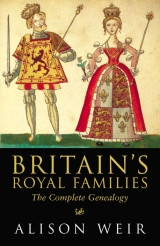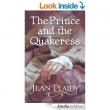
Текст книги "Britain's Royal Families"
Автор книги: Элисон Уир
Жанр:
Историческая проза
сообщить о нарушении
Текущая страница: 1 (всего у книги 21 страниц)
Contents
About the Author
Also by Alison Weir
Dedication
Foreword
1 The Saxon and Danish Kings of England
2 The Norman Kings of England
3 The Angevin or Plantagenet Kings of England
4 The Later Plantagenets: The Houses of Lancaster and York
5 The Tudors
6 The Kings and Queens of Scotland from the 9th Century to 1603
Part One: The House of MacAlpine
Part Two: The House of Dunkeld
Part Three: The House of Balliol
Part Four: The House of Bruce
Part Five: The House of Stewart
7 The House of Stuart
8 The House of Hanover
9 The House of Saxe-Coburg-Gotha becomes the House of Windsor
Author's Note
Select Bibliography
Copyright
About the Author
Alison Weir was born in London and now resides in Surrey. Before becoming a published author in 1989, she was a civil servant, then a housewife and mother. From 1991 to 1997, whilst researching and writing books, she ran a school for children with learning difficulties before taking up writing full-time. Her non-fiction books include The Six Wives of Henry VIII, Lancaster and York, Children of England, Elizabeth the Queen, Eleanor of Aquitaine, Mary Queen of Scots, Henry VIII: King and Court, Isabellaand, most recently, The Lady in the Tower. She is also the author of three best-selling novels, Innocent Traitor, The Lady Elizabethand The Captive Queen.
Alison Weir
BRITAIN’S ROYAL
FAMILIES
The Complete Genealogy

To Rankin, John and Kate
Also by Alison Weir
Non-fiction
Britain’s Royal Families: The Complete Genealogy
The Six Wives of Henry VIII
The Princes in the Tower
Lancaster and York: The Wars of the Roses
Children of England: The Heirs of King Henry VIII 1547 – 1558
Elizabeth the Queen
Eleanor of Aquitaine
Henry VIII: King and Court
Mary Queen of Scots and the Murder of Lord Darnley
Isabella: She Wolf of France, Queen of England
Katherine Swynford: The Story of John of Gaunt and His Scandalous Duchess
The Lady in the Tower: The Fall of Anne Boleyn
Fiction
Innocent Traitor
The Lady Elizabeth
The Captive Queen
Foreword
In 1965, when I was fourteen, I read for the first time an adult historical novel. It was about Katherine of Aragon, and was entirely forgettable, except for the fact that it left me with a thirst to find out more about its subject. Subsequently, I read many more novels, and then many history books, and my interest expanded from the Tudor period to encompass the whole sweep of British, indeed, European, history. But from the first, my chief fascination was with the British monarchy, and it became my ambition to produce a book that would provide the reader with a complete genealogical record of all the royal families of England, Scotland and Great Britain.
It has taken me more than 22 years to research this book. Throughout this time I have consulted countless books and articles in various libraries, visited sites of interest, and revised the manuscript at least eight times. It may seem strange, but despite the fact that there are numerous and detailed books on the British monarchy, and even on royal genealogy, there is not one that gives a complete record of all the members of the various royal houses and families. To obtain such a record, I have had to research each person individually, cross-checking the facts where possible from alternative sources, and re-checking against new works as they were published. I have used original, contemporary sources for verification wherever possible.
The result is Britain’s Royal Families, which I am convinced will prove an invaluable aid to the student of royal history, and will provide much of interest for even the most casual of royalty watchers.
Alison Weir
London, 1989
CHAPTER ONE
The Saxon and Danish Kings of England
There have been kings in England for more than 2,000 years, and yet this realm has been a monarchy for little more than half that time. Up until the Dark Ages, kingship was basically tribal, invested in chieftains of Celtic or Romano-British stock. Then, in the middle of the 5th century, England began to feel the impact of the Barbarian invasions that were changing the face of Europe. Angles, Saxons and Jutes came to these shores, settled, and then colonised the land. There then evolved 7 kingdoms, known to historians as the Heptarchy. The earliest kingdom was established in Kent by Hengist, son of a Germanic chieftain, in around A.D. 455. The other kingdoms were Essex (the East Saxons), Sussex (the South Saxons), East Anglia (the East Angles), Lindsey, Bernicia, Deira, Mercia and Wessex (the West Saxons). Lindsey was centred around Lincoln; the names of its kings are not known to us, and it was very soon swallowed up by neighbouring kingdoms. Bernicia and Deira combined later on to form the kingdom of Northumbria, the first of the biggest three kingdoms to establish supremacy over the rest.
Christianity came to Kent in the late 6th century, and soon spread to the rest of the Heptarchy, although there were pagan influences still prevalent until the late middle ages. Not so welcome were the raids of the Vikings from Scandinavia, which were the scourge of England (and other countries also) from the 8th to the 11th centuries, and which attained their ultimate achievement in the Norman Conquest of 1066.
Northumbria was the first kingdom to achieve supremacy, and during the 7th century it was a centre for the arts and religion. Unfortunately, the light of learning was extinguished during the following century because of the Viking raids. At that time, Mercia was in the ascendant. This kingdom comprised the Midlands and some of the southern counties. At its peak of supremacy, Mercia was governed by King Offa ( d.796), who established firm government and overseas alliances. However, after his death, the kingdom declined because of ineffective leadership, leaving Wessex in the ascendant.
The kingdom of Wessex had been founded in A.D. 519 by a chieftain called Cerdic, who came to Britain from Germany in 494/5. His descendants, proud to bear his name, called themselves ‘Cerdingas’. H.M. Queen Elizabeth II is a direct descendant of Cerdic. Later Saxon chroniclers would boastfully trace Cerdic’s descent from Adam and Eve, via a mythical son born to Noah in the Ark, but of course this is pure fiction, for Cerdic’s ancestors were in fact obscure tribal chieftains and elders.
Anglo-Saxon kingship was a blend of the mystical and the practical. The function of the king was to protect his people, by making war if necessary, and by giving them laws to obey. He was also sanctified by holy rites, which evolved into the coronation as we know it, the modern form of which dates from the crowning of King Edgar in 973. Anglo-Saxon kings of the House of Wessex had from time immemorial been crowned upon the ancient coronation stone at Kingston-upon-Thames, in a simple ritual which was not as complicated as the European ceremony adapted for Edgar by Archbishop Dunstan. Hence, the king, set apart by his anointing and crowning, and thereby invested with priestly attributes, was a champion of the Christian Church, who was deemed to hold his office from God.
The king was also expected to father sons for posterity, to ensure the succession and the stability of the kingdom. His wife was rarely accorded the title of ‘Queen’ in Wessex, but was usually styled ‘Lady’. Succession was by primogeniture, supporting the right of the eldest son, although on several occasions the right of conquest prevailed over this.
As late as the 11th century, the Danes were still attempting to invade and conquer a by then united England, and they were ultimately successful, which is why our line of Anglo-Saxon monarchs is broken by four Danish interlopers. As a result of this, the succession in the 11th century was an ongoing problem, which was not finally resolved until 1066. In 1100, when Henry I married a princess of Saxon descent, the old and the new royal houses at last joined in blood.
This handbook is about the monarchy, and it begins with the first ruler who properly may be accorded the title of monarch, Egbert of Wessex. Egbert was acknowledged in his time as an outstanding sovereign, who, by the end of his reign, was recognised by other, lesser, kings as overlord of most of England. For this reason, we must begin with Egbert. Unfortunately, his supremacy did not long survive his death, and the authority of his immediate descendants, the great Alfred included, was more or less confined to Wessex. It was not until more than a century after Egbert’s death that the monarchy was properly established in England under King Athelstan.

King Egbert
FATHER: Ealhmund, King of Kent.
He was the son of Eafa of Wessex by a Kentish princess, whose identity is unknown. Ealhmund is known to have been reigning in Kent in 784 or 786. He died in 786 (?).
MOTHER: Unknown.
SIBLINGS: St Alburga.
She was either the daughter of Ealhmund by his unknown wife, or the daughter of that wife by another husband. She is called the half-sister of Egbert.
Alburga married Wulfstan, who was perhaps Ealdorman of Wiltshire. Upon her widowhood, she entered her husband’s religious foundation at Wilton, which she is said to have converted into a nunnery. She died and was buried there in c.800 or c.810. Egbert did not have any brothers.
EGBERT
He was born around 769/80. He became ‘Subregulus’ of Kent in 790/96, and succeeded Beorhtric as King of Wessex in 802. There is no record of his coronation. From 825 onwards, he had established his supremacy over all other rulers in England, and was effective overlord of all the south-eastern kingdoms. In 829, he succeeded Wiglaf as King of Mercia, although he was expelled the following year.
Egbert married(although no record exists of the date or the place):
Redburga
She is said to have been the sister of the King of the Franks (who, at that time, was Charlemagne), but her identity is uncertain, and hardly anything is known about her.
Issue of marriage:
1 King Ethelwulf(  see here).
see here).
2 Athelstan
He became ‘Subregulus’ of Kent, Essex, Sussex and Surrey in 839, and also reigned as King of East Anglia. He died in c.851.
Athelstan married a lady about whom no information exists, and had issue:
(i) Ethelweard
He was ‘Subregulus’ of Kent. He died, probably unmarried, in 850.
3 Edith
She became a nun at Polesworth Abbey, Co. Warwick, where she later became Abbess. She died and was buried there, but the year is not recorded.
EGBERT
He died on 4 February (or after c.June), 839, and was buried in Winchester Cathedral. His bones are now in one of the mortuary chests there.
He was succeeded by his son Ethelwulf.

King Ethelwulf
FATHER: Egbert, King of Wessex(  see here).
see here).
MOTHER: Redburga(  see here).
see here).
SIBLINGS: (  see here).
see here).
ETHELWULF
He was born around 795/810. He became ‘Subregulus’ of Kent, Essex, Sussex and Surrey in 825 or 828, and succeeded his father as King of Wessex on 4 February, 839. He was crowned, probably that same year, at Kingston-upon-Thames, Surrey. In 855/6, he resigned Wessex to his son Ethelbald, and confined his own authority to Kent, Sussex and Essex as ‘Subregulus’.
Ethelwulf married firstly, in c.830 (although no record exists as to where):
Osburga
She was the daughter of Oslac of Hampshire or the Isle of Wight. She died in 846 or 852/5. (Osburga has sometimes been confused by historians with St Osburga, foundress of Coventry Abbey, who died c.1018).
Issue of marriage:
1 Athelstan(?)
Although some sources cite Athelstan as Ethelwulf’s eldest son, he has almost certainly been confused with Athelstan, son of King Egbert, as the details of his life are identical. It is therefore improbable that Ethelwulf actually had a son called Athelstan.
2 King Ethelbald(  see here).
see here).
3 King Ethelbert(  see here).
see here).
4 King Ethelbert I(  see here).
see here).
5 King Alfred(  see here).
see here).
6 Ethelswitha
She married, after 2 April, 853 (or 854/5), Burgred, King of Mercia ( d.874) at the Palace of Chippenham, Wiltshire. Shortly after her widowhood in 874, she became a nun. She went on a pilgrimage to Rome in 888/9, but died in Paris on the way there. She was buried at either Pavia or Ticino in Italy.
Ethelwulf married secondly, on 1 or 15 October, 856, at Verberie sur Oise, France:
Judith
She was the daughter of Charles II, King of the Franks, by Ermentrude, daughter of Odo, Count of Orléans. She was born in c.843/4, and was crowned Queen of Wessex on her wedding day.
In 860, she married secondly her stepson, King Ethelbald (  see here), at Chester, but the marriage was annulled that same year on grounds of consanguinity. She had no issue from either of these marriages.
see here), at Chester, but the marriage was annulled that same year on grounds of consanguinity. She had no issue from either of these marriages.
In c.863, she married thirdly Baldwin I, Count of Flanders ( d.c.879), at Auxerre, France, and had issue:
1 Charles (died young).
2 Baldwin II, Count of Flanders ( d.918), who married Elfrida of Wessex (  see here, under King Alfred), and had issue. One of their descendants was Matilda, wife of William I.
see here, under King Alfred), and had issue. One of their descendants was Matilda, wife of William I.
3 Rudolf, Count and Abbot of Cambrai.
4 Gunhilda, who married Wilfred I, Count of Barcelona ( d.897).
Judith died in c.870.
ETHELWULF
He died on 13 January (or late in the year), 858, and was buried in Winchester Cathedral.
He was succeeded by his son Ethelbald.

King Ethelbald
FATHER: Ethelwulf, King of Wessex(  see here).
see here).
MOTHER: Osburga(  see here, under King Ethelwulf).
see here, under King Ethelwulf).
SIBLINGS: (  see here, under King Ethelwulf).
see here, under King Ethelwulf).
ETHELBALD
He was born in c.834. He succeeded his father as King of Wessex on 13 January (or late in the year), 858, and was crowned soon afterwards at Kingston-upon-Thames, Surrey.
Ethelbald married, in 860 (although no record exists as to where):
Judith
She was his father’s widow, and the marriage was frowned upon. It was annulled that same year. There was no issue from it. (Judith’s details are given under King Ethelwulf,  see here).
see here).
ETHELBALD
He died on 20 December, 860, and was buried in Sherborne Abbey, Dorset.
He was succeeded by his brother Ethelbert.

King Ethelbert
FATHER: Ethelwulf, King of Wessex(  see here).
see here).
MOTHER: Osburga(  see here, under King Ethelwulf).
see here, under King Ethelwulf).
SIBLINGS: (  see here, under King Ethelwulf).
see here, under King Ethelwulf).
ETHELBERT
He was born in c.836. He became ‘Subregulus’ of Kent in 853 or 855, and succeeded his brother Ethelbald as King of Wessex on 20 December, 860. He was crowned soon afterwards at Kingston-upon-Thames, Surrey.
He died, unmarried and childless, in 865/6, and was buried in Sherborne Abbey, Dorset.
He was succeeded by his brother Ethelred.

Ethelred I
FATHER: Ethelwulf, King of Wessex(  see here).
see here).
MOTHER: Osburga(  see here, under King Ethelwulf).
see here, under King Ethelwulf).
SIBLINGS: (  see here, under King Ethelwulf).
see here, under King Ethelwulf).
ETHELRED I
He was born in c.840. He succeeded his brother Ethelbert as King of Wessex in 865/6, and was crowned shortly afterwards at Kingston-upon-Thames, Surrey.
Ethelred I married, in c.868 (although no record exists as to where):
(?) Wulfrida
Nothing is known of her origin or dates.
Issue of marriage:
1 Ethelwald
He was born in c.868, and set himself up as King of York and Pretender to the throne of Wessex in 901, after the death of his uncle, King Alfred. He was killed defending his claims in 902/5 at the Battle of the Holm.
Ethelwald married a professed nun from Wimborne Minster, Dorset; her name is unknown.
2 Ethelhelm
He is perhaps to be identified with:
(a) an Ealdorman of Wiltshire, or
(b) an Archbishop of Canterbury who was consecrated in 919 and who died on 8 January, 923.
There is, unfortunately, no conclusive evidence to support either theory. It is possible that Ethelhelm died in 898.
ETHELRED I
He was killed on 23 April (after Easter), 871, at the Battle of Merton, and was buried at Wimborne Minster, Dorset, although some less reliable sources give his place of burial as Sherborne Abbey, Dorset. After his death, he was popularly reputed a saint.
He was succeeded by his brother Alfred.

King Alfred
FATHER: Ethelwulf, King of Wessex(  see here).
see here).
MOTHER: Osburga(  see here, under King Ethelwulf).
see here, under King Ethelwulf).
SIBLINGS: (  see here, under King Ethelwulf).
see here, under King Ethelwulf).
ALFRED
Known as ‘the Great’, he was born in 846/9 at Wantage, Dorset. He succeeded his brother Ethelred I as King of Wessex and Danish Mercia on 23 April, 871, and was perhaps crowned at Kingston-upon-Thames, Surrey, although this is mere supposition, as there is no evidence for it.
Alfred married, in 868/9, at Winchester:
Ethelswitha
She was the daughter of Ethelred Mucel, Ealdorman of the Gainas (to be identified with Gainsborough, Lincolnshire?), by Edburga, a Princess of the Royal House of Mercia, perhaps the daughter of Coenwulf, King of Mercia, by his wife Elfrida.
After the death of King Alfred, Ethelswitha turned to religion, and became a nun at St Mary’s Abbey, Winchester, in c.901. She died in Winchester on 5 or 8 December, 905, and was buried there in St Mary’s Abbey; her remains were later removed to Winchester Cathedral. After her death, she was popularly reputed a saint.
Issue of marriage:
1 Ethelfleda
Born c.869, she married Ethelred, Ealdorman of Mercia ( d.911), in 886/7 (certainly by the end of 889), and had issue:
1 Elfwynn (904?–after 919).
Ethelfleda was recognised as Lady of the Mercians in 911, after the death of her husband. She died on 12 June, 918, at Tamworth, Staffordshire, and was buried in Gloucester Cathedral.
2 Edmund
No dates are recorded, but he was possibly the eldest son, born around 870, as he was crowned in the lifetime of his father, following a European precedent set by Charlemagne. Asser, King Alfred’s biographer, says Edmund died in infancy.
3 King Edward the Elder(  see here).
see here).
4 Elfrida
She married Baldwin II, Count of Flanders ( d.918), between 893 and 899, and had issue:
1 Arnulf, Count of Flanders ( d.964), who married Adela of Vermandois, and had issue. One of their descendants was Matilda of Flanders, wife of William I.
2 Adelulf, Count of Boulogne ( d.933).
3 Daughter.
4 Daughter.
Elfrida died on 7 June, 929 (?), in Flanders, and was buried in St Peter’s Abbey, Ghent.
5 Ethelgiva
She became a nun at Shaftesbury Abbey, Dorset, where she was elected the first Abbess in c.888. She died and was buried in Shaftesbury Abbey in c.896.
6 Ethelweard
Born c.880. Very little is known of his life. He died on 16 (?) or 26 October, 920/22.
Ethelweard married a lady about whom no information exists, and had issue:
( i) Elfwine
He was killed at the Battle of Brunanburgh in 937, and was buried in Malmesbury Abbey, Wilts.
( ii) Ethelwine
He was killed at the Battle of Brunanburgh in 937, and was buried in Malmesbury Abbey, Wilts.
( iii) Thurcytel
Born c.907, he became a monk at his own foundation at Croyland Abbey, Lincs., in c.946, and was later elected Abbot there. He died on 12 July, 975, at Croyland Abbey, and was buried there.
KING ALFRED
He died on 25, 26 or 28 October, 899, and was buried in Newminster Abbey, Winchester. His remains were later removed to Hyde Abbey, Winchester, which was destroyed during the Reformation. The present site of his grave is unknown. His bones may possibly lie in one of the mortuary chests in Winchester Cathedral.
He was succeeded by his son Edward.

King Edward the Elder
FATHER: King Alfred(  see here).
see here).
MOTHER: Ethelswitha(  see here, under King Alfred).
see here, under King Alfred).
SIBLINGS: (  see here, under King Alfred).
see here, under King Alfred).
KING EDWARD
Known as ‘the Elder’, he was born in c.871/2. He succeeded his father as King of Wessex on 25, 26 or 28 October, 899, and was crowned on 31 May or 8 June, 900, at Kingston-upon-Thames, Surrey.
Edward married firstly(although no record exists of the date or the place):
Egwina
She is described as ‘a noblewoman’, although her origins are unknown. William of Malmesbury, writing in the 12th century, states that her children were illegitimate, thereby suggesting that her marriage to Edward was uncanonical, but this is unlikely in view of the fact that her son succeeded Edward as undisputed king. She died in c.901/2.
Issue of marriage:
1 King Athelstan(  see here).
see here).
2 Alfred
No dates are recorded, and very little is known about him. He may have died young.
3 St Edith
She married Sihtric Caoch, King of Northumbria ( d.927), on 30 January, 925/6, at Tamworth, Staffordshire. After her widowhood, she became a nun at Polesworth Abbey, Warwickshire, in 927. That same year, she was transferred to Tamworth Abbey, Gloucestershire, where she was immediately elected Abbess. She died in c.927. After her death, she was canonised, and her Feast Day is 15 July.
Edward married secondly, in c.901/2 (although no record exists as to where):
Elfleda
She was the daughter of Ealdorman Ethelhelm by his wife Elswitha. She died in 920, and was buried in Winchester Cathedral.
Issue of marriage:
1 Edwin
He was perhaps ‘Subregulus’ of Kent. In 933, he drowned in the English Channel, perhaps murdered on the orders of his half-brother, King Athelstan. He was buried in St Bertin’s Abbey, Flanders.
2 Elfweard
Information about Elfweard is conflicting. One source states he married and had children, but gives no details. Another source, less trustworthy, states he was a hermit at Bridgenorth, Salop. What is certain is that he died on 1 August, 924, at Oxford, and was buried in Winchester Cathedral.
3 Edfleda
No dates are recorded. She was a nun, but her community is not named: it was perhaps Winchester. She was buried in Wilton Abbey, Wiltshire.
4 Edgiva(or Ogive )
She married Charles III, King of France ( d.929), between 916 and 919, and had issue:
1 Louis IV, King of France (921?–954), who married Gerberga ( d.984), daughter of Henry the Fowler of Saxony, Holy Roman Emperor, and had issue.
Edgiva married secondly, Heribert III, Count of Vermandois, Meaux, and Troyes ( d.995), in c.951 at St Quentin, France, and had issue:
2 Stephen I, Count of Vermandois ( b.952?–1021).
3 Agnes ( b. 953).
Edgiva died in c. 953, perhaps in childbirth. Some sources state she died in 948, in which case her second marriage took place earlier than is generally supposed.
5 Edhilda
She married Hugh Capet, Count of Paris and Duke of the French ( d.956), in 926/7, and had issue:
1 Hugh, King of France (938?–996), who married Adelaide ( d.1004/5), daughter of William, Duke of Aquitaine, and had issue. Edhilda died on 26 January, 947. (Some sources state she died in c.938, or even earlier, but this is improbable.)
6 Edith
She married Otto I, Duke of Saxony and German Emperor ( d.973), in c.925/30, and had issue:
1 Liudolf, Duke of Swabia ( d.957), who married Ida, daughter of Hermann, Duke of Almayne, Swabia, and had issue.
2 Liutgarde, married Conrad, Duke of Lorraine.
Edith died on 26 January, c.946/7, in Germany, and was buried in the Cathedral of St Maurice, Magdeburg.
7 Elfleda
She became a nun at Winchester, where she died in c.963. She was buried in Wilton Abbey, Wilts.
8 Elgiva
No dates are recorded. She married ‘a Prince near the Alps’. He has recently been identified, with near certainty, as Boleslaw II, Duke of Bohemia ( d.999). Other, less probable, identifications have been made with Conrad III, King of Burgundy ( d.993); Alberic, son of Majolus, Count of Narbonne; and Charles Constantine, King of Arles, son of either the Emperor Louis the Blind or Louis II, King of Arles.
9 Ethelfleda
No dates are recorded. She was perhaps a nun at Romsey Abbey, Hampshire, and may have been elected Abbess of Romsey, where she was later buried.
10 Ethelhilda
No dates are recorded. She was a lay sister or recluse at Romsey Abbey, Hampshire. She was buried in Wilton Abbey, Wiltshire.
Edward married thirdly, in 920 (?) (although no record exists of the date or the place):
Edgiva
She was the daughter of Sigehelm, Ealdorman of Kent, and she was born before c.905. She died on 25 August, 968, and was buried in Canterbury Cathedral.
Issue of marriage:
1 Edmund I(  see here).
see here).
2 St Edburga
She became a nun at Nunnaminster Abbey, Winchester; she was possibly elected Abbess, but this is unlikely. She died on 15 June, 960, and was buried in Nunnaminster Abbey. After her canonisation, her remains were translated to Pershore Abbey, Worcs.
3 Edgiva
She was married in infancy to ‘Louis of Aquitaine, King of Arles’, before 923. Her husband has not been successfully identified. He may have been Louis II, King of Arles, in which case the issue of the marriage may have been:
1 Charles Constantine, King of Aries (whose parentage is uncertain).
Louis may also be identified, with less credibility, with Louis the Blind, King of Lower Burgundy and Holy Roman Emperor ( d.928). Some authorities cite Ebehard, Count of Nordgau ( d.c.960), as the husband of Edgiva.
4 King Edred(  see here).
see here).
5 Thyra
She is said to have been a daughter of Edward by Edgiva, but there is some doubt about this. No dates are recorded. She married Gorm the Old, king in North Jutland, and had issue:
1 Harold I, King of Denmark ( d.986), who also married and had issue.
Edward is also reputed to have had the following illegitimate issue, although this is in dispute:
1 Gregory, Abbot of Einsiedlen in Germany.
KING EDWARD THE ELDER
He died on 17 July, 924/5, at Farndon-on-Dee, and was buried in Winchester Cathedral.
He was succeeded by his son Athelstan.








